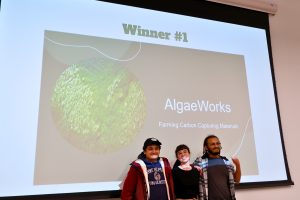
Three materials science and engineering undergraduate students were part of a team named one of the three top winners at JHU’s annual GreenHacks Innovation Challenge.
This year’s event, held February 9 through 11 at FastForward U, challenged area college students to come up with new strategies and ideas for sustainable innovations. The student teams, or “hackers,” were assigned to one of three main areas: cleaning the atmosphere, eco-friendly farming, or renewable fuel energy.
Materials science and engineering students Alex DiNovi, Fanuel Mammo, and John Carbo won for their concept, “Algae Works: Farming Carbon Capturing Material.” Understanding that the manufacturing and construction industry accounts for 21% of all carbon emissions around the world, the team—which also included a master’s student from Morgan State University—came up with a novel idea: use algae as a building material.
“We figured, what if we could get the carbon into the houses instead of just giving off all this carbon to create them?” said DiNovi.
The team’s research revealed that algae could capture and store—what’s called “sequester” in the energy and sustainability field— up to 13 tons of CO2. Moreover, they learned limestone can be produced through the photosynthesis of algae plants in bioreactors located in abandoned warehouse structures. The limestone generated by this algae can serve as an alternative to the manufacturing of cement, which is environmentally hazardous. Additionally, algae can also be used as a substitute for wood, reducing carbon emissions from forestry.
The students’ plan included the use of readily available resources and abandoned buildings in cities like Baltimore. They say that their proposal is cost-efficient, as the price of algae-based construction materials is close to that of cement.
“By using abandoned factories in carbon-positive areas, we are breathing life back into cities like Baltimore and Detroit while promoting carbon negativity,” explained DiNovi, Mammo, and Carbone in their presentation. They point out that their concept solves two problems many cities face: abandoned structures and air pollutants caused by greenhouse gases like CO2.
Their original approach set them apart because of its simplicity—rather than inventing something new, the team connected existing assets, making their innovation feasible.
“The technology already exists to create algae-based concrete and wood, but no one’s trying to manufacture it,” said DiNovi. “Manufacturing capability exists here in Baltimore. We just took those two things and put them together… We were just taking ideas. They already existed. But people hadn’t thought to put it together yet.”
Looking ahead, the team hopes to make an impact at HopStart on April 26, a competition where Hopkins students can showcase their business plans to industry leaders.